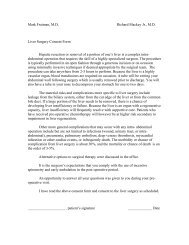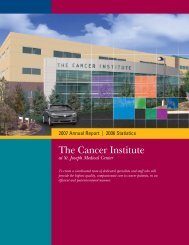A NEW DAY IN CANCER TREATMENT - St. Joseph Medical Center
A NEW DAY IN CANCER TREATMENT - St. Joseph Medical Center
A NEW DAY IN CANCER TREATMENT - St. Joseph Medical Center
- No tags were found...
You also want an ePaper? Increase the reach of your titles
YUMPU automatically turns print PDFs into web optimized ePapers that Google loves.
“ For Jen, R.N.—I met her during my lung biopsy at <strong>St</strong>. <strong>Joseph</strong> <strong>Medical</strong> <strong>Center</strong>. She did more to teach me about my cancer and itstreatment during my pre-biopsy prep than anyone had yet done. It is because of her that I made the decision to seek all of mycancer treatment at the Cancer Institute. ” s J.G.Figure 2HISTOLOGY OF TUMOR<strong>St</strong>hat laparoscopic colectomy for colon cancer is a safe alternative totraditional “open” technique when performed by a surgeon who isexperienced with this technique.The colon and rectal surgeons at the Colorectal Oncology <strong>Center</strong>,Drs. Berg and Akbari, are well-versed in the minimally-invasive/laparoscopic approach to colorectal cancer. In fact, the great majorityof the operations they perform for colorectal cancer are performed usingeither “straight” laparoscopy or a laparoscopically-assisted approach.Both surgeons, in fact, have been instructors in courses to teach othersurgeons these techniques.Our Own ResultsThe Cancer Institute takes pride in tracking and analyzing its owndata. Focusing on cancers of the colon, rectum and anus, the primarysites of these cancers from the years 2004-2008 can be seen inFigure 1. As can be seen, as with the national data mentioned earlier,colon cancer was the most prevalent, followed by rectal and anal.The histology of these tumors was overwhelmingly adenocarcinoma,the most common histology of colon and rectal cancers (Figure 2).Anal cancers have squamous histology. The most common malignancycategorized under the “other” category was the carcinoid (low-gradeneuroendocrine) histology. In regards to the age of patients with acolorectal cancer at diagnosis, the apex of the distribution curve wasin the mid 70s (Figure 3).HISTOLOGY DISTRIBUTION PERCENTAGEFigure 3NUMBER OF CASES100%90%80%70%60%50%40%30%20%10%0%35302520151050COLON RECTUM ANALST. JOSEPH <strong>CANCER</strong> <strong>IN</strong>STITUTEFIVE-YEAR COLORECTAL <strong>CANCER</strong> AGE DISTRIBUTIONAge at DiagnosisPoly. (Age at Diagnosis)Average Age = 69Median Age = 71Maximum = 95Minimum = 25AGE AT DIAGNOSISOtherRareCloagenicCarcinoidBasiloidSquamousAdenocarcinoma25 30 35 40 45 50 55 60 65 70 75 80 85 9011
















